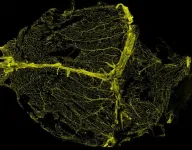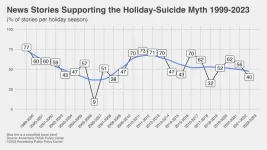(Press-News.org) A study supported by the National Institutes of Health suggests that the response of immune system cells inside the protective covering surrounding the brain may contribute to the cognitive decline that can occur in a person with chronic high blood pressure. This finding, published in Nature Neuroscience, may shed light on new ways to counteract the effects of high blood pressure on cognition. The study was funded by the National Institute of Neurological Disorders and Stroke (NINDS), a part of NIH.
“The role of immune signaling in cognitive decline is critically important to understand,” said Roderick Corriveau, Ph.D., program director, NINDS. “These findings offer insight into how signaling from the immune system could contribute to symptoms of cognitive decline that ultimately result in dementia diagnoses.”
Hypertension affects more than 1 billion people worldwide and can lead to a decline in cognitive function including when a stroke occurs, but also even when a person with high blood pressure does not have a stroke. However, efforts to control cognitive loss in people who do not experience a stroke with treatments that lower blood pressure have shown mixed results. The findings of this mouse study suggest that immune cells around and within the brain become abnormally activated under conditions that mimic a common form of hypertension, and this activation leads to impaired brain function.
Using a mouse model of high blood pressure, the researchers led by Costantino Iadecola, M.D., director and chair of the Feil Family Brain and Mind Research Institute, New York City, found abnormally increased levels of interleukin-17 (IL-17), a chemical normally released in the body to activate the immune system, in the cerebral spinal fluid and the brain. Previously, Dr. Iadecola’s team showed that a high salt diet increased IL-17 in the gut, which was followed by cognitive impairment. These new findings add to that story by showing that IL-17 is acting within the brain itself. It’s also notable that these experiments use a different mouse model, called the DOCA salt model, that more closely mimics a common form of hypertension in people.
“This is currently the most realistic model of hypertension that we have,” said Dr. Iadecola. “The DOCA mouse simulates low-renin hypertension, which is a common type of hypertension in people, particularly among Black Americans.”
Further work showed that, once in the brain, IL-17 turned on immune cells responsible for activating inflammation and fighting off infections, known as macrophages. A series of experiments confirmed that these macrophages are important for the observed decline in cognition, as both mice in which the receptor for IL-17 was deleted in brain macrophages and those that had their brain macrophages depleted showed no effects of high blood pressure on cognitive function despite having other symptoms of hypertension.
Researchers still sought the source of the IL-17 acting on the brain macrophages. Based on their previous work, the researchers’ initial hypothesis was that the gut releases IL-17, which then travels to the brain through the blood stream. Once there, it sets off a reaction that damages the ability of brain blood vessels to respond appropriately to increased brain activity. However, blocking the brain blood vessels’ ability to respond to IL-17 only partially rescued cognitive impairment, suggesting that there was another source of IL-17 acting on the brain.
One clue came from other recent studies suggesting that one layer of the protective covering of the brain, known as dura mater, contains immune T cells that can both secrete IL-17 and can affect the behavior of mice. Using special mice where cells light up fluorescent green when they make IL-17, the researchers confirmed that hypertension increases IL-17 in the dura mater which is then released into the tissue. Normally, barriers exist within the protective covering of the brain, called the meninges, to prevent unwanted spillage into the brain. However, this barrier appeared to be disrupted in the mice with experimentally induced hypertension, and this disruption allowed IL-17 to enter the cerebral spinal fluid.
Two additional experiments helped to confirm this hypothesis. First, a drug was used to prevent T cell movement from the lymph nodes into the meninges. Second, an antibody was used to block the activity of T cells in the meninges. In both cases, cognitive function was restored in the mice with hypertension, suggesting that targeting overactive T cells could be a new treatment approach worth exploring.
“Together, our data suggest two different effects are caused by hypertension,” said Dr. Iadecola. “One is IL-17 acting on blood vessels, but this appears to be relatively minor. A more prominent, central effect is caused by cells in the meninges releasing IL-17 that directly affects immune cells in the brain. It is these immune cells, activated by signaling from the meninges, that ultimately affect the brain in a way that causes cognitive impairment.”
Dr. Iadecola and his team are now looking to connect the dots between the activation of immune cells in the meninges and decreased cognitive function. Previous work by the group suggested a connection between a high salt diet which suppressed the production of the chemical nitric oxide in brain vessels that in turn led to buildup of tau, a toxic protein that forms clumps in neurons affected by Alzheimer’s disease. The present findings also show suppression of nitric oxide production within brain vessels, and whether this also leads to an increase in tau production is currently under investigation.
The NINDS’s Mind Your Risks® campaign serves to highlight the connection between high blood pressure and brain health (including risk of stroke and dementia), particularly among Black men ages 28-45, and offers strategies to prevent and mitigate high blood pressure’s effects on brain health.
This study was funded by NINDS (NS089323, NS095441, NS123507), the Leon Levy Fellowship in Neuroscience, and the Feil Family Foundation.
Article:
Santisteban MM et al. “Meningeal IL-17 producing T cells mediate cognitive impairment in salt-sensitive hypertension” Nature Neuroscience Dec. 4, 2023. DOI: 10.1038/s41593-023-01497-z
###
NINDS (http://www.ninds.nih.gov) is the nation’s leading funder of research on the brain and nervous system. The mission of NINDS is to seek fundamental knowledge about the brain and nervous system and to use that knowledge to reduce the burden of neurological disease.
About the National Institutes of Health (NIH): NIH, the nation's medical research agency, includes 27 Institutes and Centers and is a component of the U.S. Department of Health and Human Services. NIH is the primary federal agency conducting and supporting basic, clinical, and translational medical research, and is investigating the causes, treatments, and cures for both common and rare diseases. For more information about NIH and its programs, visit https://www.nih.gov.
END
Salty immune cells surrounding the brain linked to hypertension-induced dementia
NIH-funded study in mice offers possible new target for high blood pressure treatments
2023-12-04
ELSE PRESS RELEASES FROM THIS DATE:
Dark galactic region nicknamed "The Brick" explained with Webb telescope findings
2023-12-04
In a recent study led by University of Florida astronomer Adam Ginsburg, groundbreaking findings shed light on a mysterious dark region at the center of the Milky Way. The turbulent gas cloud, playfully nicknamed “The Brick” due to its opacity, has sparked lively debates within the scientific community for years.
To decipher its secrets, Ginsburg and his research team, including UF graduate students Desmond Jeff, Savannah Gramze, and Alyssa Bulatek, turned to the James Webb Space Telescope (JWST). The implications of their observations, published in ...
Awareness, accessibility, and affordability are crucial for the early detection of thalassemia
2023-12-04
- Interviewing Dr. Androulla Eleftheriou, Executive Director at TIF, and Dr. Zhiyu Peng, Deputy GM at BGI Genomics, Head of the World Hemoglobinopathy Foundation
Thalassemia, a hereditary hemoglobinopathy, occurs in 4.4 out of every 10,000 live births and is prevalent in Mediterranean coastal areas, Africa, the Middle East, Southeast Asia, and southern China.
Screening and antenatal diagnosis reduced the frequency of β-thalassemia in many Mediterranean countries. Focusing on other regions with high thalassemia prevalence, BGI Genomics has launched the Global 2023 State of Thalassemia Awareness Report, covering 1,847 ...
Complications from flu largely preventable with annual flu vaccine
2023-12-04
ARLINGTON, Va., BETHESDA, Md., CHICAGO and DALLAS, Dec. 4, 2023 — During National Influenza Vaccination Week (December 4-8, 2023), leading public health organizations are encouraging everyone to get a flu shot if they have not already done so. The flu is more than an inconvenience: it can lead to hospitalization, worsening of chronic medical conditions or even death. An annual flu vaccine is the best way to help prevent complications from the flu. [1]
The American Heart Association®, the American Lung Association,® the American ...
Soil drought weakens forest microclimatic cooling
2023-12-04
Scientists from Stockholm University have investigated the mechanisms that create cool microclimates beneath forest canopies during warm and dry summer days. The study reveals how canopy shading and water evaporation together create cooler forest microclimates compared to temperatures outside forests. The article is published in Agricultural and Forest Meteorology.
”The findings are alarming in the context of climate change as more frequent and more severe droughts may threaten the cooling functions of forests,” says Caroline Greiser, researcher at the Physical Geography Department, Stockholm ...
Study shows advanced footwear technology positively impacts elite sprint performances
2023-12-04
A scientific study published in PeerJ Life & Environment sheds light on the potential game-changing impact of advanced footwear technology (AFT) on elite sprint performances in track and field. The research, titled "The Potential Impact of Advanced Footwear Technology on the Recent Evolution of Elite Sprint Performances," reveals the significant strides made in sprint performance and suggests that AFT has played a pivotal role in these improvements.
Elite track ...
What's behind the holiday-suicide myth
2023-12-04
PHILADELPHIA – For more than two decades, the Annenberg Public Policy Center has tracked the ways in which news organizations erroneously link the year-end holiday season with suicide, perpetuating the false holiday-suicide myth. But as years of national data show, the winter holiday months usually have low average daily suicide rates, with December the lowest of all.
In our new media analysis, we find that of the newspaper stories during the 2022-23 holiday season that explicitly connected the holidays with suicide, 60% correctly debunked the myth while 40% incorrectly supported it.
But it’s not just the media that ...
More than a meteorite: New clues about the demise of dinosaurs
2023-12-04
What wiped out the dinosaurs? A meteorite plummeting to Earth is only part of the story, a new study suggests. Climate change triggered by massive volcanic eruptions may have ultimately set the stage for the dinosaur extinction, challenging the traditional narrative that a meteorite alone delivered the final blow to the ancient giants.
That’s according to a study published in Science Advances, co-authored by Don Baker, a professor in McGill University’s Department of Earth and Planetary Sciences.
The research team delved into volcanic eruptions of the Deccan Traps—a ...
INU scientists propose a model to predict personal learning performance for virtual reality-based safety training
2023-12-04
In Korea, occupational hazards are on the rise, particularly in the construction sector. According to a report on the ‘Occupational Safety Accident Status’ by Korea’s Ministry of Employment and Labor, the industry accounted for the highest number of accidents and fatalities among all sectors in 2021. To address this rise, the Korea Occupational Safety and Health Agency has been providing virtual reality (VR)-based construction safety content to daily workers as part of their educational training initiatives.
Nevertheless, ...
Placing nanoparticles in the palm of your hand
2023-12-04
Nanoparticles are super tiny―as small as one nanometer, or one billionth of a meter―and are of keen interest to materials scientists for their unique physical and chemical properties. They cannot be detected by the naked eye and require a highly specialized electron microscope to be seen.
In fact, advancements in imaging technologies through the 1990s and early 2000s are what made the field of nanoscience possible, says Anne Bentley, a faculty member in the Department of Chemistry at Lewis & Clark College in Portland, Oregon.
“I ...
Rice engineers tackle hard-to-map class of materials
2023-12-04
HOUSTON – (Dec. 4th, 2023) – The properties that make materials like semiconductors so sought after result from the way their atoms are connected, and insight into these atomic configurations can help scientists design new materials or use existing materials in new, unforeseen ways.
Rice University materials scientist Yimo Han and collaborators mapped out the structural features of a 2D ferroelectric material made of tin and selenium atoms, showing how domains ⎯ areas of the ...
LAST 30 PRESS RELEASES:
Anthropologists offer new evidence of bipedalism in long-debated fossil discovery
Safer receipt paper from wood
Dosage-sensitive genes suggest no whole-genome duplications in ancestral angiosperm
First ancient human herpesvirus genomes document their deep history with humans
Why Some Bacteria Survive Antibiotics and How to Stop Them - New study reveals that bacteria can survive antibiotic treatment through two fundamentally different “shutdown modes”
UCLA study links scar healing to dangerous placenta condition
CHANGE-seq-BE finds off-target changes in the genome from base editors
The Journal of Nuclear Medicine Ahead-of-Print Tip Sheet: January 2, 2026
Delayed or absent first dose of measles, mumps, and rubella vaccination
Trends in US preterm birth rates by household income and race and ethnicity
Study identifies potential biomarker linked to progression and brain inflammation in multiple sclerosis
Many mothers in Norway do not show up for postnatal check-ups
Researchers want to find out why quick clay is so unstable
Superradiant spins show teamwork at the quantum scale
Cleveland Clinic Research links tumor bacteria to immunotherapy resistance in head and neck cancer
First Editorial of 2026: Resisting AI slop
Joint ground- and space-based observations reveal Saturn-mass rogue planet
Inheritable genetic variant offers protection against blood cancer risk and progression
Pigs settled Pacific islands alongside early human voyagers
A Coral reef’s daily pulse reshapes microbes in surrounding waters
EAST Tokamak experiments exceed plasma density limit, offering new approach to fusion ignition
Groundbreaking discovery reveals Africa’s oldest cremation pyre and complex ritual practices
First breathing ‘lung-on-chip’ developed using genetically identical cells
How people moved pigs across the Pacific
Interaction of climate change and human activity and its impact on plant diversity in Qinghai-Tibet plateau
From addressing uncertainty to national strategy: an interpretation of Professor Lim Siong Guan’s views
Clinical trials on AI language model use in digestive healthcare
Scientists improve robotic visual–inertial trajectory localization accuracy using cross-modal interaction and selection techniques
Correlation between cancer cachexia and immune-related adverse events in HCC
Human adipose tissue: a new source for functional organoids
[Press-News.org] Salty immune cells surrounding the brain linked to hypertension-induced dementiaNIH-funded study in mice offers possible new target for high blood pressure treatments








